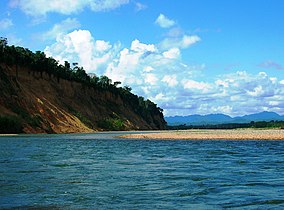
Back Parc nacional Madidi Catalan Madidi National Park CEB Národní park Madidi Czech Nationalpark Madidi German Εθνικό Πάρκο Μαδίδι Greek Parque nacional Madidi Spanish Madidin kansallispuisto Finnish Parc national Madidi French הפארק הלאומי מאדידי HE Մադիդի (ազգային պարկ) Armenian
This article may require copy editing for grammar, style, cohesion, tone, or spelling. (April 2024) |
| Madidi National Park | |
|---|---|
 Madidi National Park, Bolivia | |
| Location | La Paz, Bolivia |
| Nearest city | Rurrenabaque, Beni |
| Coordinates | 13°48′0″S 67°38′0″W / 13.80000°S 67.63333°W |
| Area | 18,957.5 km2[1] |
| Established | September 21, 1995 |
| Governing body | SERNAP Servicio Nacional de Áreas Protegidas |
Madidi (Spanish pronunciation: [maˈðiði]) is a national park in the upper Amazon river basin in Bolivia. It was established in 1995 with a total land area of 18,958 km2 (approximately 11,779 sq mi).[2] Together with the nearby (though not all contiguous) protected areas Manuripi-Heath and Apolobamba and the Manu Biosphere Reserve (Peru), Madidi is part of one of the largest protected areas in the world.[3]
Ranging from the Andes Mountains to the rainforests of the Tuichi River, Madidi was recognized in 2018 by the Wildlife Conservation Society as the world's most biologically diverse national park.[4][5] Madidi extends to protect parts of the Bolivian Yungas and Bolivian montane dry forests ecoregions.[6]
Madidi National Park is accessible from San Buenaventura by crossing the Beni River via passenger ferry from Rurrenabaque.
The local inhabitants who migrated here from the Andean highlands speak the Quechua language. The park is home to indigenous groups including the Tacanan-speaking Tacana and Ese Ejja, the closely related Tsimané and Mosetén, and the voluntarily isolated Toromona.[7][8][9]
Ecolodges are found in and around the Madidi National Park, the oldest and best known being Chalalan Ecolodge in Chalalán on the Tuichi River, a community-based enterprise that generates economic benefits for indigenous communities.[10]
- ^ "SERNAP". Archived from the original on 2007-12-19. Retrieved 2008-02-10.
- ^ "Right to Name New Monkey Auctioned for Conservation". Environment News Service, international daily newswire. 2005-02-10. Retrieved 2007-09-25.
- ^ "Is This the World's Most Diverse National Park?". The New York Times. 2018-05-22. ISSN 0362-4331. Retrieved 2018-05-28.
- ^ Hays, Brooks (22 July 2018). "Bolivia's Madidi National Park is most biodiverse in the world". UPI.com. Retrieved 8 July 2023.
- ^ "Wildlife Conservation Society". Archived from the original on 2008-01-30. Retrieved 2008-02-10.
- ^ Olson, D. M, E. Dinerstein; et al. (2001). "Terrestrial Ecoregions of the World: A New Map of Life on Earth". BioScience. 51 (11): 933–938. doi:10.1641/0006-3568(2001)051[0933:TEOTWA]2.0.CO;2.
{{cite journal}}: CS1 maint: multiple names: authors list (link) - ^ "THE EXPEDITION TO APOLOBAMBA". Retrieved 2007-09-23.
- ^ Alcázar, José Luis (2006-06-09). "BOLIVIA: In Search of the Toromona". www.ipsnews.net. Inter Press Service News Agency. Retrieved 2019-12-09.
- ^ Berton, Eduardo Franco (2016-10-05). "Hydropower threatens Bolivian indigenous groups and national park". Mongabay Environmental News. Retrieved 2019-12-09.
- ^ Malky Harb, Alfonso; Pastor Saavedra, Cándido; Limaco Navi, Alejandro; Mamani Capiona, Guido; Limaco Navi, Zenón; Fleck, Leonardo C. (2007). El efecto Chalalán: Un ejercicio de valoración económica para una empresa comunitaria (PDF). Conservation Strategy Fund.
